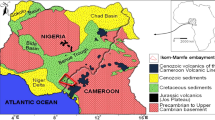Abstract
The airborne geophysics has been extensively applied and used to characterize rich reservoir of copper and gold, for example, using remanence magnetization methods. Factors such as costs, time and data quality need to be accounted in order to approach large geological rock mass such as Granite batholith. However, to assess the source of groundwater within any rock formation, it is ideally better to apply both airborne geophysics and geochemistry to indirectly correlate the parameters of both the rock formation and groundwater source at its vicinity. This paper presented a case study in relation to an assessment and investigation of groundwater sources and the geological parameters of rock formation and linked to assess the quality (groundwater segment classification and salinity), against the guidelines set for the protection of beneficial uses of groundwater.





Similar content being viewed by others
References
Bala AF, Batelaan O, De Smedt F (2000) Using landsat 5 imaging and modelling. NMGS 36:85–92
Binley A, Hubbard SS, Huisman JA, Revil A, Robinson DA, Singha K, Slater LD (2015) The emergence of hydrogeophysics for improved understanding of subsurface processes over multiple scales. Water Resour Res 51:3837–3866. doi:10.1002/2015WR017016
Caponella F (1989) Remote sensing image interpretation for groundwater surveying. In: Remote sensing application to water resources: Report of the 13th UN/FAO/UNESCO International Training course; RSC series 50, pp 281–292
Cresswell RG, Herczeg AL (2004) Groundwater recharge, mixing, and salinity across the Angas-Bremer Plains, South Australia: Geochemical and isotopic constraints. CSIRO Land and Water Technical Report No. 29/04/BRS Technical Report June 2004. vii + pp 64
Ellefson KJ, Hsieh PA, Shapiro AM (1999) Relation between seismic velocity and hydraulic conductivity at the USGS fractured rock research site. In Morganwalp DW, Buxton HT, (eds) U.S. Geological Survey Toxic Substances Hydrology Program-Proceedings of the Technical Meeting, Charleston, South Carolina, March 8–12, 1999: U.S. Geological Survey Water-Resources Investigation Report 99-4018C, v. 3, pp 735–745
Elueze AA, Omidiran JO, Nton ME (2004) Hydrogeochemical investigation of surface water and groundwater around Ibokun, Ilesha area, southwestern Nigeria. NMGS 40:57–64
Etim ON, Managan Ch, Mirohosseini MH (2000) A geophysical survey of the geological structures of the lower alluvial valleys of Rivers Cagne and Malvan, France. NMGS 36:29–38
Freeze RA, Cherry JA (1979) Groundwater. Prentice-Hall, Englewood Cliffs, p 604
Hearst JR, Nelson PH, Paillet FL (2000) Well Logging for physical properties. Wiley, West sussex, p 483
Hem JD (1985) Study and interpretation of the chemical characteristics of natural water. 3rd ed. USGS water supply paper 1473
Johnson CD, Lane JW, Jr, Williams JH, Haeni FP (2001) Application of Geophysical methods to delineate contamination in fractured rock at the University of Connecticut landfill, Storrs, Connecticut. In: Symposium on the application of geophysics to engineering and environmental problems, Oakland, California, March 4–7, 2001, proceedings: Wheat Ridge, Colo., Environmental and Engineering Geophysical Society
KeysWS (1990) Borehole geophysics applied to ground-water investigations: U. S. Geological Survey Techniques of Water-Resources Investigations, book 2, chap. E2, 150 p
Lane JW, Jr, Day-Lewis FD, Harris JM, Haeni FP, Gorelick SM (2000) Attenuation-difference radar tomography—results of a multiple-plane experiment at the U.S. Geological Survey fractured-rock research site, Mirror Lake, New Hampshire. In: Noon DA, Stickley GF, Longstaff D (eds) GPR 2000. Proceedings of the eighth international conference on ground penetrating radar: University of Queensland, Queensland, Australia, pp 666–675
Nwachukwu BN, Ananaba SE, Onu NN (1990) Geophysical survey for groundwater at the federal University of Technology, Owerri permanent site. Technical report. p 6
Senior LA, Goode DJ (2017) Effects of changes in pumping on regional groundwater- flow paths, 2005 and 2010, and areas contributing recharge to discharging wells, 1990–2010, in the vicinity of North Penn Area 7 Superfund site, Montgomery County, Pennsylvania: U.S. Geological Survey Scientific Investigations Report 2017–5014, 36 p. doi:10.3133/sir20175014
Shapiro AM, Hsieh PA, Haeni FP (1999) Integrating multidisciplinary investigations in the characterization of fractured rock. In: Morganwalp DW, Buxton HT (eds) U.S. Geological Survey Toxic Substances Hydrology Program-Proceedings of the Technical Meeting, Charleston, South Carolina, March 8–12, 1999. U.S. Geological Survey Water-Resources Investigation Report 99-4018C, v. 3, pp 669–680
Voronin LM, Cauller SJ (2017) Simulated groundwater flow paths, travel time, and advective transport of nitrogen in the Kirkwood-Cohansey aquifer system, Barnegat Bay–Little Egg Harbor Watershed, New Jersey: U.S. Geological Survey Scientific Investigations Report 2016–5169, p 17. doi:10.3133/sir20165169
Williams JH, Conger RW (1990) Preliminary delineation of contaminated water-bearing fractures intersected by open-hole bedrock wells. Ground Water Monit Rev 10(4):118–126
Yihdego Y (2016a) Evaluation of flow reduction due to hydraulic barrier engineering structure: case of urban area flood, contamination, and pollution risk assessment. J Geotech Geol Eng 34(5):1643–1654. doi:10.1007/s10706-016-0071-1
Yihdego Y (2016b) Hydraulic in situ testing for mining and engineering design: packer test procedure, preparation, analysis, and interpretation. J Geotech Geol Eng 35(1):29–44. doi:10.1007/s10706-016-0112-9
Yihdego Y (2017a) Engineering and enviro-management value of radius of influence estimate from mining excavation. J Appl Water Eng Res. doi:10.1080/23249676.2017.1287022
Yihdego Y (2017b) Simulation of groundwater mounding due to irrigation practice: case of wastewater reuse engineering design. Hydrol J 4:19. doi:10.3390/hydrology4020019. http://www.mdpicom/2306-5338/4/2/19
Yihdego Y, Al-Weshah R (2016) Assessment and prediction of saline sea water transport in groundwater using 3-D numerical modelling. Environ Process J 4(1):49–73. doi:10.1007/s40710-016-0198-3
Yihdego Y, Webb JA (2015) Use of a conceptual hydrogeological model and a time variant water budget analysis to determine controls on salinity in Lake Burrumbeet in southeast Australia. Environ Earth Sci J 73(4):1587–1600. doi:10.1007/s12665-014-3509-x
Yihdego Y, Danis C, Paffard A (2017) Why is the groundwater level rising? A case study using HARTT to simulate groundwater level dynamics. J Water Environ Res. doi:10.2175/106143017X14839994523785
Author information
Authors and Affiliations
Corresponding author
Ethics declarations
The authors thank anonoumous reviewers. The manuscript has benefitted from the reviewers’ and editors’ comments.
Rights and permissions
About this article
Cite this article
Yihdego, Y., Nzikou, M.M. Application of Airborne Geophysics and Geochemistry to Characterize Groundwater Flow Path. Geotech Geol Eng 36, 1175–1184 (2018). https://doi.org/10.1007/s10706-017-0382-x
Received:
Accepted:
Published:
Issue Date:
DOI: https://doi.org/10.1007/s10706-017-0382-x




